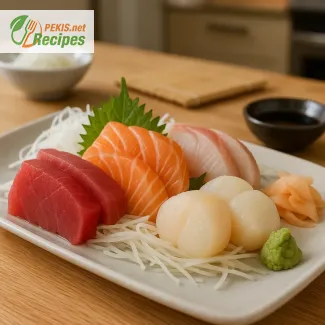
Master the Art of Slicing: Traditional Japanese Sashimi Explained
Discover the cultural essence and culinary precision behind Japan’s most elegant raw dish
In the realm of Japanese cuisine, few dishes are as revered and artistically celebrated as sashimi. Unlike sushi, which pairs raw fish with vinegared rice, sashimi strips away everything except the core: pristine slices of raw fish, presented with simplicity and elegance. Whether you're a culinary enthusiast, a seafood connoisseur, or simply someone looking to expand their skills in the kitchen, learning how to prepare sashimi at home offers a deeply satisfying and culturally enriching experience.
The word sashimi literally means "pierced body," a reference rooted in tradition. Its origins trace back to Japan’s Muromachi period, when fish was carefully sliced and skewered with fin or tail to distinguish species. Today, the name carries less dramatic meaning and more culinary finesse. The dish is defined by precision knife work, the quality and freshness of the fish, and a presentation style that evokes balance, seasonality, and harmony.
To prepare authentic sashimi at home, the most critical element is the selection of sushi-grade fish. This term, often seen in seafood markets and specialty shops, indicates that the fish has been frozen at ultra-low temperatures to eliminate parasites, making it safe to eat raw. Typical choices include tuna (maguro), salmon (sake), yellowtail (hamachi), sea bream (tai), and scallops (hotate). While the availability of these varieties may vary by region, the freshness and handling are non-negotiable. When purchasing, look for a vibrant color, firm texture, and a clean ocean scent—these are visual and olfactory cues of fish suitable for sashimi.
Another defining feature of sashimi is the knife technique, traditionally executed with a long, thin blade called a yanagiba. This allows for clean, single-motion cuts that preserve the integrity and texture of the fish. Slicing should be done against the grain at a consistent angle to enhance tenderness. Even the thickness of each slice matters—too thick, and the texture is overwhelming; too thin, and the flavor lacks presence. The goal is balance, both visually and on the palate.
Presentation in sashimi is not merely decorative—it is a meditative act that respects both the ingredient and the diner. The fish is often arranged on chilled plates or bamboo mats, accompanied by garnishes like daikon radish, shiso leaves, wasabi root, and pickled ginger. Each component plays a functional role: wasabi adds heat, ginger cleanses the palate, and daikon provides a refreshing crunch. Most importantly, sashimi is always served with soy sauce, but it should be lightly dipped—never soaked—to avoid overpowering the delicate flavor of the fish.
Though sashimi is traditionally enjoyed in restaurants or by trained chefs, more and more home cooks are embracing this art form. Thanks to the growing accessibility of high-quality raw fish, specialty Japanese ingredients, and professional tools, it is now possible to replicate a restaurant-worthy sashimi platter in a home kitchen. That said, it's crucial to remember that sashimi isn’t about improvisation or shortcuts. It’s about respect—for the fish, the knife, the process, and the tradition.
Because “sashimi” is not a registered trademark, there are no legal restrictions in using this term for recipes. It remains a globally recognized culinary category, much like “pasta” or “tapas.” However, one should never imply that a dish is from a specific Japanese brand, chef, or proprietary method unless explicitly referencing it. This recipe focuses on the general traditional method and ingredients, adapted for home preparation with authenticity in mind.
To successfully recreate sashimi at home, you must understand its essence: purity, minimalism, and technique. Every step, from selecting the fish to the final plating, should be approached with care and intention. Unlike cooked dishes, sashimi leaves no room to mask imperfections. It is raw in every sense of the word—an honest and unfiltered expression of the sea.
In the sections below, we will guide you step by step through the tools you’ll need, how to prepare your ingredients, and how to present your sashimi with Japanese-style precision.
Step 1: Prepare the workstation
Thoroughly clean all cutting boards and knives. Place your fish and scallops on crushed ice to keep them chilled while you prepare.
Step 2: Slice the daikon radish
Using a mandoline or sharp knife, cut the daikon radish into ultra-thin julienne strips. Soak in ice water for 10 minutes to enhance crispness, then drain and set aside.
Step 3: Slice the sashimi
Using a yanagiba or long, sharp sashimi knife, slice the tuna, salmon, and yellowtail against the grain into clean, even slices, about 7 mm (¼ inch) thick and 5–7 cm (2–3 inches) long. The motion should be one long pull, not a sawing motion.
Step 4: Prepare the scallops
Cut the scallops in half horizontally if large, maintaining a round, neat shape.
Step 5: Plate the sashimi
Arrange the sliced fish and scallops on a chilled plate in groups. Add the daikon strips in the center, tuck in shiso leaves beneath the slices, and place a small mound of wasabi at one side. Add pickled ginger as a garnish.
Step 6: Serve with soy sauce
Pour the soy sauce into small dipping bowls. Serve immediately, ensuring everything is cold and fresh.
Elevating Sashimi: Expert Tips to Refine the Classic Japanese Raw Fish Experience
Enhance flavor, presentation, and nutrition in your homemade sashimi with precision and creativity
Sashimi, the quintessential Japanese raw fish dish, is widely celebrated for its elegance, purity, and respect for ingredients. While traditionally prepared by skilled chefs in Japan, many home cooks today are eager to replicate the experience in their own kitchens. The good news is that sashimi is an accessible recipe for those willing to understand its nuances. But beyond simply following a traditional method, there are refined techniques and creative touches that can elevate sashimi to something even more personal, flavorful, and impressive.
Choosing the right fish: Beyond the basics
The foundation of great sashimi is, without question, the fish itself. Traditional varieties such as tuna, salmon, and yellowtail are excellent choices, but home chefs can go further by exploring lesser-used yet equally flavorful options like mackerel (saba), sea bream (tai), arctic char, or sweet shrimp (amaebi). Each variety offers a different taste profile—mackerel brings a deep umami richness, while arctic char delivers a buttery, delicate flavor that’s perfect for newcomers.
Upgrading to wild-caught fish or responsibly farmed options can also improve both flavor and sustainability. Ensure that any fish used is sushi-grade, a designation indicating that it’s safe for raw consumption due to proper freezing and handling practices.
Knife technique: Refining your slice
One of the easiest ways to elevate homemade sashimi is by mastering the art of slicing. While traditional yanagiba knives are ideal, any long, sharp blade with a thin edge can produce quality results. The key is to slice against the grain in one clean stroke, which maintains the integrity of the flesh and produces a smooth texture.
Experimenting with different slicing techniques can also affect mouthfeel. For instance, thinner slices of fatty fish like salmon create a melt-in-your-mouth sensation, while slightly thicker cuts of firm fish like tuna deliver a satisfying bite.
Enhancing the plate with color and texture
Classic sashimi presentation often includes shiso leaves, daikon radish, and wasabi, but more vibrant additions can enhance both flavor and visual appeal. Try including microgreens, edible flowers, or thinly sliced cucumber ribbons for freshness. Roasted seaweed strips add umami and crunch, while thinly sliced avocado provides creaminess that balances lean fish.
Instead of serving soy sauce in a standard dish, consider infusing it with a few drops of yuzu juice or adding a pinch of grated ginger. This adds brightness and complexity without overpowering the fish. For a mild sweetness, a dash of mirin can soften overly salty soy sauce.
Temperature and timing: Serving at peak freshness
One of the biggest advantages of preparing sashimi at home is controlling the timing of service. Fish is best sliced and served cold, not frozen or overly chilled. Let it rest for just a few minutes at room temperature before plating to bring out the subtle oils and natural flavors. Avoid the common mistake of letting the fish sit too long before serving, as it quickly loses texture and aroma.
Healthier alternatives and dietary considerations
Traditional soy sauce is high in sodium and can contain gluten. Substituting it with tamari or low-sodium soy sauce can make sashimi more accessible to those with dietary restrictions. If you’re looking to reduce saturated fat, opt for leaner fish varieties like sea bass or flounder instead of salmon or toro.
To increase the nutritional value, consider serving sashimi with a side of seaweed salad, citrus-marinated vegetables, or even quinoa or brown rice for a more filling meal while keeping the focus on freshness and clean eating.
Common mistakes and how to avoid them
A frequent error in sashimi preparation is mishandling the fish. Fish should be stored just above freezing and used within 24 hours of purchase for peak freshness. Improper knives or dull blades can tear the flesh, which not only looks unprofessional but also compromises texture.
Overcomplicating the dish is another trap. Sashimi is about restraint and balance. Avoid excessive garnishes or strong sauces. The fish should remain the star of the plate, not be overwhelmed by surrounding elements.
Making sashimi more personal
While the roots of sashimi lie in tradition, modern cooks can personalize their experience. Introduce regional influences by pairing sashimi with elements from Mediterranean, Scandinavian, or Latin cuisines. For example, add a light drizzle of olive oil and sea salt over tuna slices or serve scallops with a touch of lime zest and chili flakes for a fusion twist.
Those with culinary curiosity can also experiment with light cures. A 10-minute cure using kombu (kelp) wrapped around white fish adds a depth of umami known as “kombujime,” a classical but lesser-known Japanese technique.
Why homemade sashimi is better
Beyond cost savings, homemade sashimi allows full control over quality, hygiene, and customization. In restaurants, sashimi is often pre-sliced or served in fixed varieties. At home, you choose the exact fish, prepare it to your taste, and serve it at the ideal moment.
The process itself becomes a meditative, mindful activity, fostering a deeper appreciation for the ingredients. You build a relationship with the food—selecting, slicing, and plating with intention—something no takeout experience can replicate.
Evolving the classic
Improving traditional sashimi doesn’t mean reinventing it. Instead, it involves refining each element—from fish selection to blade angle, from soy dipping enhancements to presentation choices. With knowledge, creativity, and attention to detail, you can transform this minimalist Japanese classic into a personalized culinary statement that rivals the best sushi counters.
Allergens present in the recipe:
- Fish (tuna, salmon, yellowtail, scallops)
- Soy (soy sauce)
Gluten presence:
- Soy sauce may contain gluten depending on the brand.
Suggested substitutions for allergens and gluten:
- Use tamari instead of regular soy sauce for a gluten-free version.
- For fish allergies, this dish is not recommended and cannot be adjusted without changing its fundamental nature.
Vitamins and minerals per serving (approximate):
- Vitamin D – 10 µg: Supports bone health and immune function
- Vitamin B12 – 5 µg: Essential for nerve function and red blood cell formation
- Vitamin A – 200 µg: Supports vision and skin health
- Iodine – 120 µg: Supports thyroid hormone production
- Selenium – 45 µg: Antioxidant function, supports metabolism
- Omega-3 fatty acids – 1.5 g: Supports heart and brain health
- Magnesium – 70 mg: Supports muscle and nerve function
- Zinc – 3 mg: Supports immune function and healing
Antioxidants per serving (approximate):
- Astaxanthin (from salmon) – 1.2 mg: Reduces oxidative stress, supports skin and cardiovascular health
- Wasabi-derived isothiocyanates – 0.5 mg: Anti-inflammatory and antimicrobial properties
- Polyphenols from soy sauce – 15 mg: Contribute to cellular protection and reduce inflammation
- Vitamin E – 2 mg: Protects cells from oxidative damage and supports immune health





